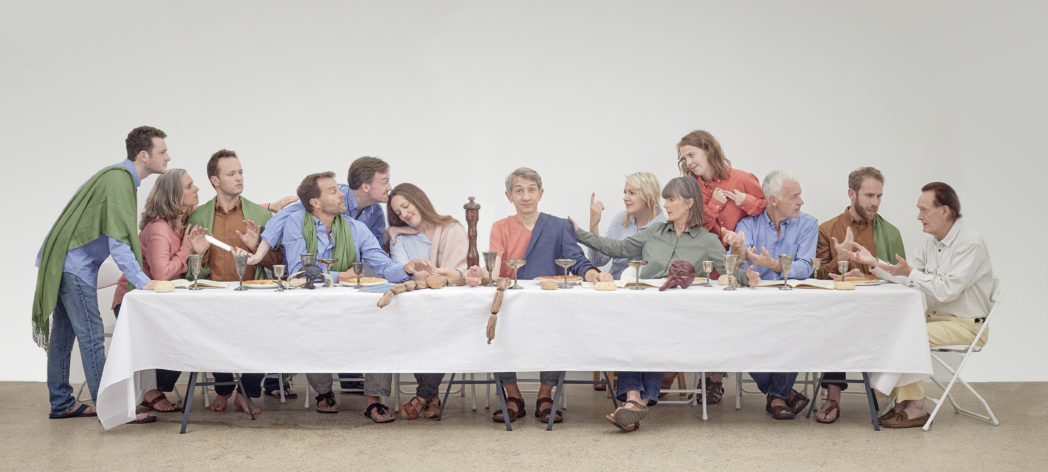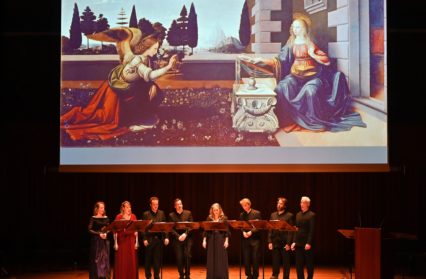To commemorate five hundred years since the death of Leonardo da Vinci, Cath Barton attended St George’s Bristol to witness Shaping the Invisible by I Fagiolini.
Robert Hollingworth, the ever-inventive director of the solo-voice consort I Fagiolini, has collaborated with Leonardo da Vinci expert Professor Martin Kemp for the ensemble’s latest touring and recording project, Shaping the Invisible. In a celebration of the 500th anniversary of the death of the great polymath, Hollingworth has chosen music to match with some of Leonardo’s artworks, and indeed his ideas. In a concert held in the splendid acoustic of St George’s Bristol on the very date of Leonardo’s death these pairings held a special resonance.
Most of the music post-dates Leonardo, but emotions transcend time, and it was an emotional connection that Hollingworth urged upon us in his introductory remarks, whatever that might be for any individual. The opening image of the Salvator Mundi is well-known to many, the reassuring gaze accompanying, and being accompanied by, Thomas Tallis’s similarly well-known and comforting 5-part motet of the same name written in 1575. This piece is so expansive that it seems timeless, as did the image of Christ the saviour. The contrasting 1936 setting of the same text by Herbert Howells offered another perspective on the painting. Hollingworth’s juxtapositions of early and twentieth century/contemporary music are always fascinating and show how they reflect elements of one another.

While insisting that their objective was the enjoyment of art through the prism of music and vice versa, and not “an archaeological exercise”, Hollingworth and Kemp also provided us with a wealth of information in what was in effect a richly illustrated lecture. So, in the Salvator Mundi, the orb which Christ holds in his left hand is a representation of a rock crystal sphere which shows the limits of the then known world, while at the same time Leonardo acknowledged the existence of a further, unknown world.
Leonardo was a mathematician, and believed that mathematics ruled both painting and music. There is an unknown element in this, nonetheless, and it was fascinating to hear Kemp speak about the elusive and ineffable qualities of Leonardo’s portrayal of the human face and his understanding, after 1500, of the eye and how light affects it. The anatomical limitations of sight also relate to Renaissance views about women, at that time always out of reach, unattainable. Two of his representations of woman are illuminated in this concert. Looking at La Scapigliata (The Head of a Woman) we hear Cipriano da Rore’s richly polyphonic setting of Petrach’s sonnet of yearning ‘Or che’l ciel e la terra’ (542), while in Monteverdi’s ‘Era l’anima mia’ (1605) the polyphony is reduced, the music lustrous, as we view that most famous of Leonardo’s paintings, the mysterious Mona Lisa.
Adopting a Swingle Singers style, the ensemble gave us J S Bach’s precisely figured Art of Fugue No 1 (c 1740-50) as we considered the precise proportions of the human body in Leonardo’s Vitruvian Man, and went on to explore the notion of order in music and art in the only pairing in the concert with a composer who was contemporary with Leonardo and who he would probably have known – Josquin Desprez. I found it a peculiarly satisfying experience to listen to the eight singers sounding the sinuous lines of the Agnus Dei from Josquin’s ‘Missa L’homme armé sexti toni’ (c 1490-1500), while myself following the pathways of the intricate knots of Leonardo’s Fantasia dei Vinci projected above their heads.
The first half of the concert ended with a different side of Leonardo – his lost painting the Battle of Anghiari, as portrayed in a drawing by Rubens, together with Leonardo’s own drawings of fantastical war machines. To mirror this Hollingworth has chosen an early example of equally fantastical programme music: in his onomatopoeic La Guerre (1528) Janequin has his four singers deploy all the sounds of war, from exploding cannons to trumpet sounds and the pounding of horses’ hooves.
Vecchi is another composer who invites singers to conjure up a panoply of sounds, and in a scene in Venetian dialect from his madrigal comedy L’Amfiparnaso (1597), five singers spit and spat at one another like Leonardo’s Five Grotesque Characters, the counterpoint to his portrayal of the beautiful and no less enthralling.
Before that the mysteries of The Annunciation and The Last Supper were paired with music with matching texts by Victoria, ‘Alma redemptoris mater’ (1581) and ‘Unus ex discipulis meis’ (1585) respectively. Hollingworth told of how the weave of the garments worn by the angel and Mary in The Annunciation had drawn him to the aural weave of the Victoria’s Marian antiphon, while Kemp drew attention to the tendons standing out on Judas’s neck in The Last Supper, not far from Leonardo’s representations of his grotesques. The textures of the music mirror and highlight these physical textures. Or at least that is one way of looking and listening; each of us finds our own. And more than once I imagined Leonardo standing behind one of the pillars in the lowered lights in St George’s, wondering at it all.
And so to the further illuminations of more recent musical compositions. The angularity of Rubbra’s interpretation of Judas’s betrayal in Amicus meus (1962), ending on an open chord, contrasts with the reverent quietude at the end of Victoria’s responsory for Maundy Thursday.
Settings by the French composer Jean-Yves Daniel-Lesur, a pupil of Messiaen, of texts from the Song of Songs highlight the close relations between the spiritual and the sexual in Leonardo’s explicitly seductive portrayal of St John the Baptist. Set as religious pieces, La Voix du Bien-Aimé and Le Jardin Clos (1952) nonetheless convey extreme sensuality. The ambiguities are visceral.
This fascinating window on the range of Leonardo’s imagination, through the perspective of music sung peerlessly by the nine singers of I Fagiolini, concluded with a new commission from Adrian Williams to a text by Gillian Clarke. Shaping the Invisible (2018) – which was how Leonardo famously described music – is concerned with the mysteries of flight. But this is less about Leonardo’s dream machines and more about bats, their glidings, their soundings and the elusive, murmuring and magical music of time.
Tour dates for I Fagiolini’s project Shaping the Invisible, directed by Robert Hollingworth, with presenter Professor Martin Kemp, can be found here, together with information about the accompanying CD.
Header Photo Credit of I Fagiolini: Mark Allan/Barbican
You might also like…
Elin Williams travelled to the Bristol Old Vic to witness a collaboration with Sherman Cymru, called Before It Rains by Katherine Chandler.
Cath Barton won the New Welsh Writing AmeriCymru Prize for the Novella with The PlanktonCollector, which is published by New Welsh Review under their Rarebyte imprint. Her second novella will be published by Louise Walters Books in 2020, and in early 2021 Retreat West Books will publish her collection of short stories inspired by the work of the Flemish artist Hieronymus Bosch.



 Enjoyed this article? Support our writers directly by buying them a coffee and clicking this link.
Enjoyed this article? Support our writers directly by buying them a coffee and clicking this link.







